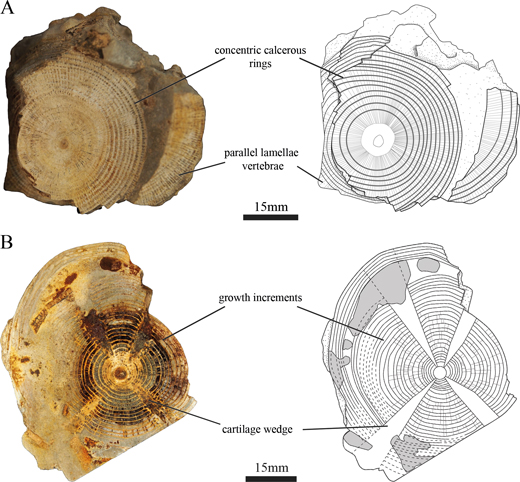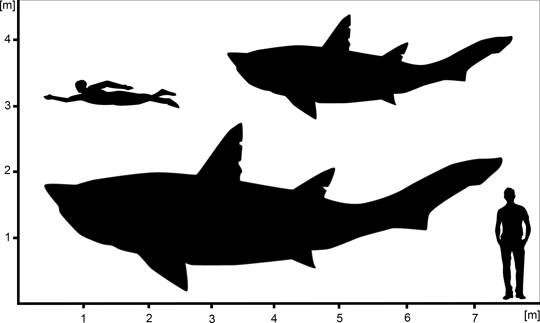New Late Cretaceous Giant Shark from Spain
Ptychodontid Sharks Grew Big and Lived for a Long Time
Scientists from the University of Vienna have been able to determine the approximate age and to estimate the rate of growth of an extinct species of shark that lived around 85 million years ago. In addition, the researchers, writing in the open access on-line journal PLOS One, have estimated that this ammonite crunching fish could have been in excess of seven metres in length, but even though it was a giant, this shark was not yet fully mature and still had some growing to do.
Much of what we know about prehistoric sharks comes from studies of their fossilised teeth. However, apart from providing indications on size, taxonomy and potential diet, these teeth do not provide a great deal of information about the life and the age of the individual. In contrast, the calcified vertebrae of elasmobranchs (sharks, skates and rays), specifically the centra, yield important information about ecological and biological traits. Two fossil shark vertebrae assigned to the genus Ptychodus found in northern Spain, have enabled researchers to gain valuable information on the life of a single individual animal that lived during the Late Cretaceous.
Site Photographs of the Shark Vertebrae

Picture credit: K. Oppermann
A Shark from Northern Spain
The fossil material consists of a portion of the spine representing five articulated and several disarticulated vertebral centra from a single animal. The fossils were found in Upper Cretaceous strata around six miles west of the town of Santander in northern Spain, from a limestone exposure close to the village of Soto de la Marina.
The extensive marine sediments document much of the Late Cretaceous – ranging from early Santonian through to Maastrichtian-aged deposits. The shark fossils come a bedding plane representing the earliest Santonian (circa 85 million years ago). Although no teeth were found in association with the fossil material, the scientists have referred this material to the Ptychodus genus. A relatively common and widespread genus that specialised in eating hard-shelled animals such as shellfish and ammonites (duraphagous diet).
Calculating the Size of the Prehistoric Shark
Previous research had shown a link between the total length attained for several living shark species and the diameter of the vertebral centra. The linear regression used to calculate potential length was applied to these fossils and the scientists concluded that the shark was between 4.3 to 7.07 metres in length.
Estimating the Size of the Ptychodus spp.
Picture credit: Patrick L. Jambura (University of Vienna)
Intriguingly, the centra of sharks also preserve evidence of growth rate, from which an age range can be deduced, just as the rings on a tree stump can provide an indication of the tree’s age. An analysis of the centra from two fossils indicated that this shark was around thirty years old when it died, quite an age for a shark, although what age some sharks species alive today can live to remains unknown. Based on this study, the researchers propose that ptychodontid sharks grew very slowly, matured very late, but also showed high longevity and had the potential to reach huge body sizes.
Calcification Pattern on the Centra Can Provide an Indication of Growth Rate and Age

Picture credit: PLOS One (Jambura and Kriwet)
The scientific paper: “Articulated remains of the extinct shark Ptychodus (Elasmobranchii, Ptychodontidae) from the Upper Cretaceous of Spain provide insights into gigantism, growth rate and life history of ptychodontid sharks” by Patrick L. Jambura and Jürgen Kriwet published in PLOS One.
The Everything Dinosaur website: Everything Dinosaur.


